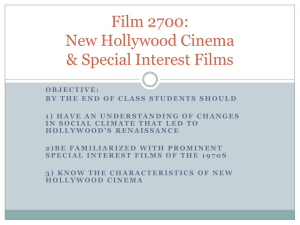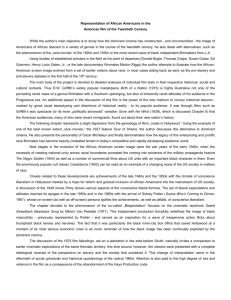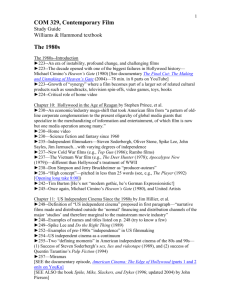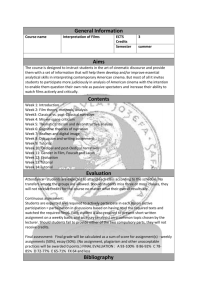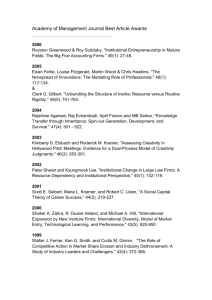5.19 - UO Blogs
advertisement
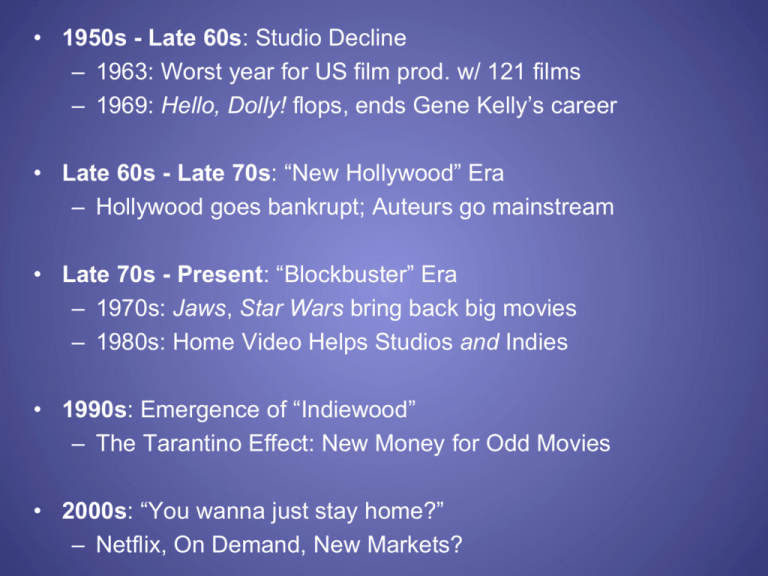
• 1950s - Late 60s: Studio Decline – 1963: Worst year for US film prod. w/ 121 films – 1969: Hello, Dolly! flops, ends Gene Kelly’s career • Late 60s - Late 70s: “New Hollywood” Era – Hollywood goes bankrupt; Auteurs go mainstream • Late 70s - Present: “Blockbuster” Era – 1970s: Jaws, Star Wars bring back big movies – 1980s: Home Video Helps Studios and Indies • 1990s: Emergence of “Indiewood” – The Tarantino Effect: New Money for Odd Movies • 2000s: “You wanna just stay home?” – Netflix, On Demand, New Markets? American History Cliffs Notes • 1959-1975: Vietnam War • 1964: Civil Rights Act • 1967-1968: Assassinations of Malcolm X, MLK, Bobby Kennedy • 1969: Stonewall Rebellion • 1974: Nixon Resigns • 1981-1989: Reagan • 1981: First U.S. AIDS Case • 1980s: “War on Drugs” • 1989/1991: Fall of Berlin Wall/Fall of USSR • 1993-2001: Clinton New Hollywood Era • • • • Who Makes Hollywood “New”? – Independent, Film-School-Educated, AuteurStyle Directors like Coppola, Scorsese, Kubrick, Woody Allen Thematically – Moral Ambiguity, Rebellion and Anti-Heroism – Sex, Drugs, Rock n Roll – Revision of Established Genres • Ex. McCabe and Mrs. Miller (Western), Bonnie and Clyde (Gangster Picture), Chinatown (Film Noir) Aesthetically – Experimental use of sound (rock n roll!) – Flashback and forward, Jump Cuts, Long takes – Lyrical treatment of violence Politically – Paranoia and General Distrust of Authority – Skepticism Toward “American Dream” – Disillusionment with Consumerism Hollywood Blockbuster Era • Growing Budgets: – Batman (1989): 50 Million – Titanic (1997): 200 Million – Pirates (2007): 300 Million • “Franchise” pictures: – Sequels, Action/Adventure Movies – Target Audience: 12-29 year-olds (75%) • Fast-Paced, Special effects-driven: – CGI, Motion Capture, Digital Sound, 3-D & 3-D Animation – Quick Cuts: Fom 4-6 seconds/shot in ‘85 to 2-3 seconds/shot in 2000s 1970s • • • • • • • • • • Star Wars (1977) Jaws (1975) The Exorcist (1973) Grease (1978) The Sting (1973) National Lampoon's Animal House (1978) The Godfather (1972) Superman (1978) Close Encounters of the Third Kind (1977/80) Smokey and the Bandit (1977) 1980s • E.T (1982) • Return of the Jedi (1983) • The Empire Strikes Back (1980) • Batman (1989) • Raiders of the Lost Ark (1981) • Ghostbusters (1984) • Beverly Hills Cop (1984) • Back to the Future (1985) • Indiana Jones and the Last Crusade (1989) • Indiana Jones and the Temple of Doom (1984) 1990s • Titanic (1997) • Star Wars: Episode I - The Phantom Menace (1999) • Jurassic Park (1993) • Forrest Gump (1994) • The Lion King (1994) • Independence Day (1996) • The Sixth Sense (1999) • Home Alone (1990) • Men in Black (1997) • Toy Story 2 (1999) 2000s • • • • • • • • • • Avatar (2009) The Dark Knight (2008) Shrek 2 (2004) Pirates of the Caribbean: Dead Man's Chest (2006) Spider-Man (2002) Transformers 2 (2009) Star Wars: Episode III Revenge of the Sith (2005) The Lord of the Rings: The Return of the King (2003) Spider-Man 2 (2004) The Passion of the Christ (2004) What makes a movie independent? • Its Funding: – Does funding from a major studio disqualify a film from the ‘independent’ category? • Its Audience: – Smart people and cinephiles? A micro-targeted market segment? • Its Distribution: – Does it get a theatrical release? Does it play in multiplexes? Art house theaters? • Its Director/Writer/Actors: – Are auteur-driven films independent? Is a David Lynch movie ‘automatically’ independent? What about Michael Mann? • Its Aesthetics: – Does deviation from classical Hollywood conventions make a film independent? The ‘Indie’ Umbrella History of the Indie • • • • Late 1970s: – U.S. Alternative/Art films go underground – Ex. Eraserhead (1977) 1980s: – ‘Mini-Majors’ and Major Indies – Ex. Sex, lies, and videotape (1989) 1990s: – Hollywood conglomerates establish ‘specialty’ divisions – Ex. Pulp Fiction (1994) 2000s: – Most ‘Indies” are produced and/or distributed through major studios; – “Indie” becomes a genre descriptor – Ex. Juno (2007) Why The American Indie Grew • 1. Home Video – 1976: VHS introduced – 1988: Majority of U.S. Households own VCR – 1997: DVD Introduced; Netflix launches, currently at 23 million subscribers – 2000: Hollywood takes in $20 billion in home video revenue (3x domestic box office) – 2010: Blockbuster Video files for bankruptcy • 2. Hollywood Funders Seek Niche Markets – Big pictures dominate, but there’s still money on the table – Mini-Majors, Specialty Divisions, “Indiewood” • 3. Film Festivals Connect Buyers and Sellers – Connecting independent films and major distributors – Ex. Steven Soderbergh’s sex, lies, and videotape debuts at Sundance 1989, Grosses $100 million What Does a Typical “Indie” Film Look Like? • • • Thematically – Focus on the “offbeat” and “quirky” • Marketed to audiences not served by Blockbusters – More likely to have: • Anti-heroes, Ambiguity, NonMainstream Values and Politics Aesthetically – Formal “flourishes” (i.e., discontinuous editing) • But usually w/ some kind of narrative or character-based justification – Strong personal vision of director – Lower budgets – Non-Professional and Character Actors Politically – All over the map, really – Often designed to challenge viewers, make them think This Week: The Watermelon Woman (1996) • Director: Cheryl Dunye • Country: United States (filmed in Philadelphia) • Movement: New Queer Cinema • Formal Focus: Sound (Ch. 9) • Why Are We Watching It? – Good intro to the low-budget American “indies” of the 1990s (think Clerks, Reservoir Dogs, etc.) – Raises questions about race and sexuality in American cinema – It works well in dialogue with other films we’ve watched, esp. Perfumed Nightmare, 8½, and Sherlock Jr. – It’s smart and fun The Watermelon Woman (1996) In Three Claims • 1. Cinema is a way of creating and validating personal identity. • 2. American Film History does not represent the history and lived experiences of AfricanAmericans or LGBT people. • 3. When your history seems to be absent, you either have to dig it up or create a totally new history. African Americans And Hollywood • • • • • History of Hollywood Racism – e.g. Al Jolson in The Jazz Singer (1927), Disney’s Song of the South (1946) All-Black Film Productions: – Oscar Micheaux (1920s and 30s) Black Actors in Hollywood – Hattie McDaniel (1939), Sidney Poitier (1963) Blaxploitation and African-American Indies – Sweet Sweetback’s Baadasssss Song (1971), Shaft (1971), Foxy Brown (1974) – William Greaves’s Symbiopsychotaxiplasm (1968), Burnett’s Killer of Sheep (1977) African-American Indies in the 1990s: – Spike Lee’s Do The Right Thing (1989), Malcolm X (1992); John Singleton’s Boyz n the Hood (1991) New Queer Cinema • • • • • Avant-Garde Roots: – Kenneth Anger’s “Fireworks” (1947) Early 1990s: “New Queer Cinema” – Todd Haynes’s Poison (1991), Gus van Sant’s My Own Private Idaho (1991), Rose Troche’s Go Fish (1994) Themes: – Documenting (mostly young, mostly urban) LGBT Life and Love: “We Exist” – Often subtle critiques of discrimination, Response to AIDS The NEA Debates (1990s) – Some “New Queer” films funded by federal grants; Congress defunds NEA 2000s: Queer Cinema Goes Mainstream: – Brokeback Mountain (2005), Milk (2008) Questions To Consider • Why does Cheryl want to find the Watermelon Woman? • When is the sound conspicuous? When is it diegetic and when nondiegetic? • How does this film compare with other films we’ve watched to this point? • What makes this movie “Indie”?

